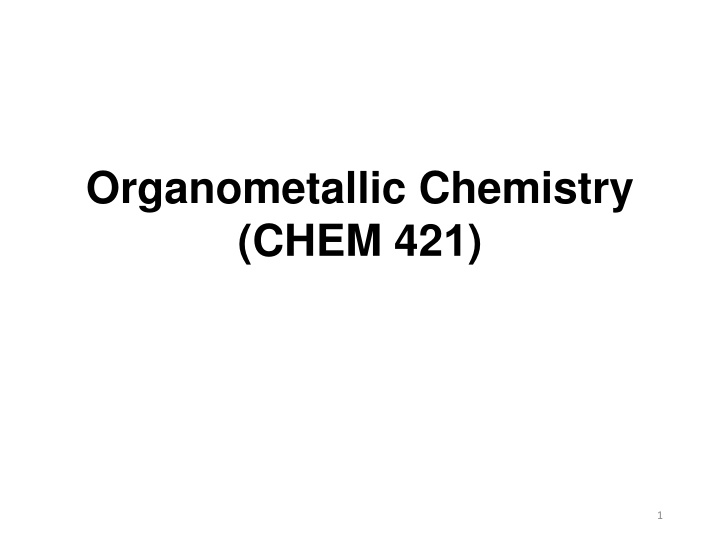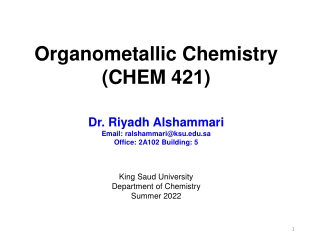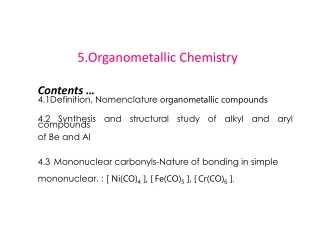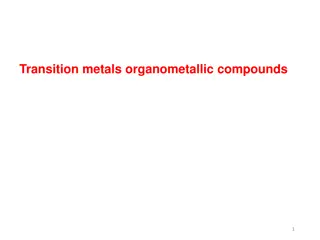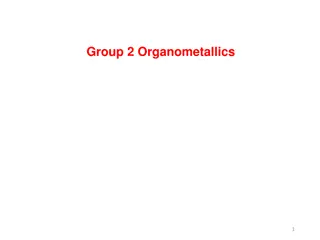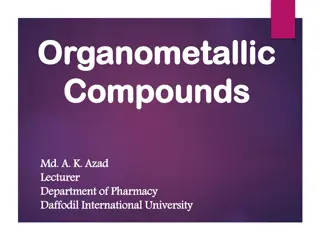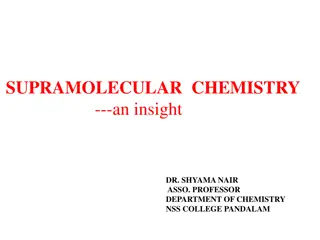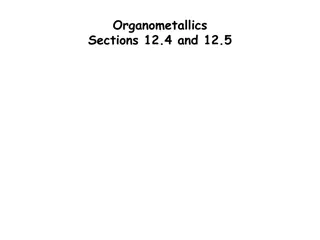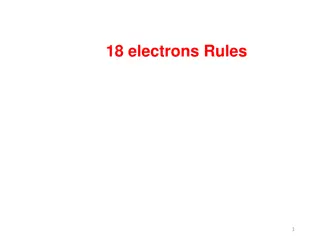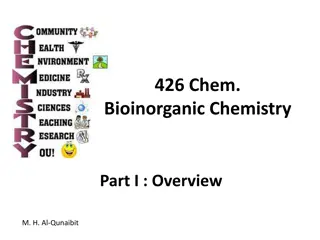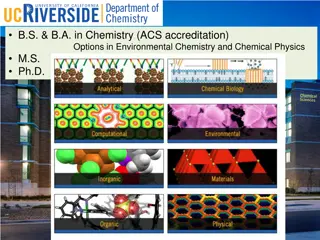Organometallic Chemistry Overview
Organometallic chemistry involves compounds with carbon-metal bonds, combining aspects of inorganic and organic chemistry. Learn about nomenclature, examples, and more in this field.
Download Presentation

Please find below an Image/Link to download the presentation.
The content on the website is provided AS IS for your information and personal use only. It may not be sold, licensed, or shared on other websites without obtaining consent from the author.If you encounter any issues during the download, it is possible that the publisher has removed the file from their server.
You are allowed to download the files provided on this website for personal or commercial use, subject to the condition that they are used lawfully. All files are the property of their respective owners.
The content on the website is provided AS IS for your information and personal use only. It may not be sold, licensed, or shared on other websites without obtaining consent from the author.
E N D
Presentation Transcript
Organometallic Chemistry (CHEM 421) 1
Introduction Organometallic chemistry is the study of organometallic compounds, chemical compounds containing at least one chemical bond between a carbon atom of an organic molecule and a metal, including alkali, alkaline earth, and transition metals, and sometimes broadened to include metalloids like boron, silicon, and selenium, as well Since many compounds without such bonds are chemically similar, an alternative may be compounds containing metal element bonds of a largely covalent character. Organometallic chemistry combines aspects of inorganic chemistry and organic chemistry. Ferrocene Tris(triphenylphosphine)rhodium carbonyl hydride 2
Organometallic compounds Organometallic compounds (metal organyls, organometallics) are defined as materials which possess direct, more or less polar bonds M + C - between metal and carbon atoms. In addition to the traditional metals, lanthanides, actinides, and semimetals, elements such as boron, silicon, arsenic, and selenium are considered to form organometallic compounds, e.g. organoborane compounds such as triethylborane (Et3B). (Carbon always more electronegative compared to M) 3
For Example [Cr(H2O)6]3+ is a coordination complex, while Cr(CO)6 is an organometallic compound which involve metal-carbon bond. Both are octahedral, CO and H2O are donor ligands; in addition, CO is a strong acceptor (letter we will study about acceptor) 4
Nomenclature of Organometallic Compounds These compounds are named by first naming the organic group and then adding the metal name directly to the group name. For Example CH3Na methylsodium C2H5-Na ethylsodium C6H5-Na phenylsodium CH3MgBr methylmagnesium bromide (This is an example of a Grignard reagent) Compound that has a considerable ionic character names as a salt, or as for sodium naphthalide Na[C10H8]. 5
Nomenclature of Organometallic Compounds n (eta): The term is used to describe if the ligands can bind through more than one carbon atom (n), which is helpful to express the coordination mode of a ligand. If n = 1 then no need to write the 1 down. n (mu): The term is used to describe the ligands that bridge more than one metal centre (n). If n = 1 then the ligand is not bridging! If n = 2 then we don t need to write the 2 down. 6 6
Classification based on the nature of Metal-Carbon bond There are four types of organometallic compounds based on the nature of M-C bond as below: Ionic - with most Group 1 elements Covalent - with many Group 12, 13, 14 and 15 elements Electron deficient - with Li, Be, Mg, B, Al Transition metal organometallic compounds The below tables representing the type of organometallic compounds: 7
Ionic Ionic organometallic compounds are generally formed from elements such as sodium, potassium etc. where the metals are considered electropositive. If the organic groups are able to delocalise the negative charge over several carbon atoms then less electropositive elements like magnesium can also form ionic compounds, eg Cp2Mg. In this case the charge is considered to be delocalize over each of the five carbon atoms in each ring. Cp2Mg Covalent The simplest model of the M-C bond is where it consists of essentially a single covalent 2-electron bond. These compounds are often volatile and are comparable to typical organic compounds being soluble in organic solvents. For example of the covalent bonded organometallic compound is CH3MgBr. 9
Electron deficient Electron deficient organometallic compounds are generally associated with elements that have less than half-filled valence shells and are designated as such because of an insufficient number of valence electrons to allow all the atoms to be linked by traditional two-electron two-centre bonds. The compounds often have bridged or polymeric structures. The methyl derivatives of Li, Be and Al are found to be 3-D polymers, linear chains and dimeric respectively and despite the increase in RMM of the monomeric unit there is actually an increase in volatility. Compound RMM of monomeric unit Structure Volatility LiMe 21.96 3D-polymer infusible BeMe2 39.08 Linear chain sublimes at 473 K AlMe3 72.08 Dimer Melts at 288 K 10
-Bonding This is common with transition metals and zero-valent Lanthanides. Ferrocene bis-benzene chromium bis-(1,3,5-But3C6H3)-gadolinium 11
To evaluate the polarity of a bond, the electronegativity difference between the neighboring atoms electronegativity values in the table below are based on the Pauling thermochemical method of determantion is usually employed. The Electronegativity values according to Pauling 13
Stability of Organometallic Compounds The stability of organometallic compounds depend on the nature of the metal and organic ligand to which they are attached. The thermal stability generally decrease down a Group. This trend in stability is a consequence in part of the decrease in the bond strength of M-C going down within a group, except the d-block group which the stability and M-C bond strength increase going down a group. Kinetic Stability Calculations of free energy would suggest that many organometallic compounds should be unstable. However, kinetic stability needs to be considered as well since if there is no low activation energy pathway for a reaction to proceed then it may be very slow. 14
Stability to Oxidation All organometallic compounds are expected to be thermodynamically unstable with respect to oxidation to give metal oxide, carbon dioxide and water. Some are spectacularly; so, being highly pyrophoric. In general organometallic compounds need to be handled under dry nitrogen or some other inert gas to avoid oxidation. Stability to Hydrolysis Hydrolysis of organometallic compounds often involves nucleophilic attack by water which is accentuated when there are low-lying empty orbitals on the metal atom. This is seen for Groups I, II and for Zn, Cd, Al, Ga etc and the speed of hydrolysis is dependent on the M-C bond polarity. For "Me3Al" rapid attack occurs whereas Me3B is unaffected at room temperature. 15
